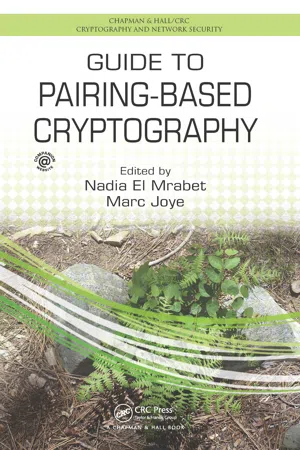
- 410 pages
- English
- PDF
- Available on iOS & Android
Guide to Pairing-Based Cryptography
About This Book
This book is devoted to efficient pairing computations and implementations, useful tools for cryptographers working on topics like identity-based cryptography and the simplification of existing protocols like signature schemes.
As well as exploring the basic mathematical background of finite fields and elliptic curves, Guide to Pairing-Based Cryptography offers an overview of the most recent developments in optimizations for pairing implementation. Each chapter includes a presentation of the problem it discusses, the mathematical formulation, a discussion of implementation issues, solutions accompanied by code or pseudocode, several numerical results, and references to further reading and notes.
Intended as a self-contained handbook, this book is an invaluable resource for computer scientists, applied mathematicians and security professionals interested in cryptography.
Frequently asked questions
Information
Table of contents
- Cover
- Half Title
- Series Page
- Title Page
- Copyright Page
- Table of Contents
- Foreword
- Symbol Description
- 1: Pairing-Based Cryptography Sébastien Canard and Jacques Traoré
- 2: Mathematical Background Jean-Luc Beuchat, Nadia El Mrabet, Laura Fuentes-Castañeda, and Francisco Rodríguez-Henríquez
- 3: Pairings Sorina Ionica and Damien Robert
- 4: Pairing-Friendly Elliptic Curves Safia Haloui and Edlyn Teske
- 5: Arithmetic of Finite Fields Jean Luc Beuchat, Luis J. Dominguez Perez, Sylvain Duquesne, Nadia El Mrabet, Laura Fuentes-Castañeda, and Francisco Rodríguez-Henríquez
- 6: Scalar Multiplication and Exponentiation in Pairing Groups Joppe Bos, Craig Costello, and Michael Naehrig
- 7: Final Exponentiation Jean-Luc Beuchat, Luis J. Dominguez Perez, Laura Fuentes-Castaneda, and Francisco Rodriguez-Henriquez
- 8: Hashing into Elliptic Curves Eduardo Ochoa-Jiménez, Francisco Rodríguez- Henríquez, and Mehdi Tibouchi
- 9: Discrete Logarithms Aurore Guillevic and François Morain
- 10: Choosing Parameters Sylvain Duquesne, Nadia El Mrabet, Safia Haloui, Damien Robert, and Franck Rondepierre
- 11: Software Implementation Diego F. Aranha, Luis J. Dominguez Perez, Amine Mrabet, and Peter Schwabe
- 12: Physical Attacks Nadia El Mrabet, Louis Goubin, Sylvain Guilley, Jacques Fournier, Damien Jauvart, Martin Moreau, Pablo Rauzy, and Franck Rondepierre
- Bibliography
- Index